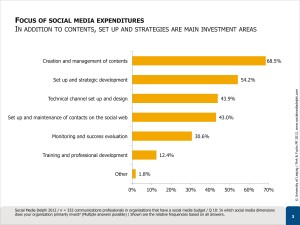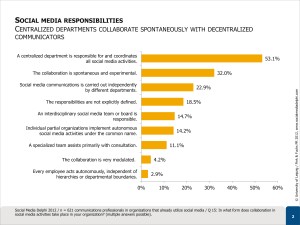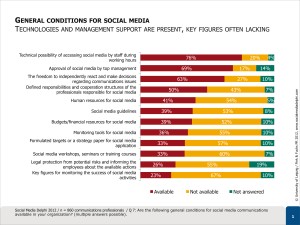Social Media Communications in Corporations and Organizations: Larger budgets, more management support, yet still little evaluation
Corporations and other organizations in Germany are handling the topic of social media communications more and more strategically. Most have moved beyond the experimentation stage. The learning processes of the past few years has led to increased investments in overall organizational structures. This is one of the key results identified by the nationwide study Social Media Governance 2012 (Delphi) in Germany, for which 860 communications professionals working in companies, governmental institutions, associations and non-profit organizations were surveyed by the University of Leipzig.
Klicken Sie auf den unteren Button, um den Inhalt von www.slideshare.net zu laden.
The joint project with Fink & Fuchs Public Relations (Wiesbaden) and the professional magazine “pressesprecher” (Berlin) was conducted for the third time in a row and can therefore be used to show developments over time. The quantitative findings reported here will be subsequently condensed into future outlooks for social media communications by an expert panels of intellectual leaders from the media, business and science.

Rising investments in social media
The expansion of social media structures and their integration into existing processes is the key starting point for successful communication via Facebook, Twitter, YouTube and other participative platforms. This primarily also requires financial resources. The study reveals a positive trend in this regard − around 39 percent of the surveyed communications professionals state that they have special budgets allocated to social media communications. This is a year-on-year increase of 22 percentage points. Organizations with a longer experience in social media and a larger number of social media activities more often have a separate budget. Similarly, larger companies and listed corporations are better positioned in this regard.
The majority of respondents (64 percent) expect this budget to increase in the future. Non-governmental organizations (NGOs) and listed corporations expect the most improvements, while governmental institutions expect less. Investments focus mainly on the creation and management of contents (69 percent), as well as on developing communication concepts and overall strategies (54 percent) (see Figure 1).
No dominant patterns for the integration of social media in organizational processes
Currently, 72 percent of surveyed organizations actively apply social media in their communications activities, while 20 percent plan to do so or use social media passively. In half of all cases there are now clearly defined responsibilities and cooperation structures. Organizations with long-term social media experience or a large number of social media activities are even further advanced.

However, collaboration styles within organizations are described very diversely and in many cases still resemble experimental phases (see Figure 2). At just about one in three of the surveyed organizations, social media communications collaboration is rather spontaneous and experimental, and at almost 19 percent the responsibilities are not explicitly defined. The majority of the respondents report about centrally controlled collaboration routines, while decentralized approaches are stated almost as frequently. This is an indication that collaboration is handled differently at various levels and often several organizational models are combined. One positive trend is the fact that 15 percent of all organizations have build up a specific, interdisciplinary social media team. Last year, only 11.5 percent of respondents reported about such a board. Collaboration issues are most important because more than 60 percent of the surveyed organizations allow their employees to decide independently about communications issues and react on their own behalf.
Also of interest is a look at the different types of organizations. While social media activities in all companies, governmental institutions, political institutions, associations and NGOs are increasingly coordinated by a centralized department, this is already the most important approach in private companies and governmental institutions. Among NGOs in particular, many handle social media communications spontaneously and experimentally (24 percent of answers) or through autonomous staff members (4 percent). Among listed corporations, possibly also due to the size of the organizations, interdisciplinary and teams focusing primarily on consulting are the most prevalent.
Social media guidelines provide orientation
When employees act independently, a special degree of co-orientation and coordination is required. The study shows that currently 39 percent of the surveyed organizations have social media guidelines as a supportive instrument. This is a year-on-year increase of eight percentage points. However, there are some obstacles to the introduction and set-up of guidelines. The development is often described as complicated because there is a need to balance clear rules with the freedom to act spontaneously and authentic in social media environments. Moreover, works councils and legal departments have to be involved when setting up guidelines.
This is why social media guidelines undergo several developmental stages that are reflected in the answers to the survey. Of the organizations that have guidelines, around 31 percent are in an early stage of planning and coordinating, at 50 percent guidelines are in force without limitations, while at 14 percent they are under revision or have already been revoked. On average, social media guidelines address seven different areas. The most frequently stated aspects are “behavioral etiquette in social media” (11 percent of answers), “contact persons for social media activities” (9 percent of answers), and the “separation of professional and private comments” (10 percent of answers).
Sporadic evaluation instead of integrated measurement systems
A special challenge is the evaluation of the wide scope of activities and dynamically changing contents of the social web. Almost eight in ten respondents state not using any specific key performance indicators (KPIs) for social media communications. Such indicators are only used to a larger extent by very active organizations and those who have long-term social media expertise. Among governmental agencies and NGOs substantially less KPIs are applied than in companies. The overall increase of eight percentage points over the previous year should therefore not hide the fact that there is still considerable room for improvement. Those organizations which already evaluate their social media activities apply different methods of social media evaluation. 79 percent can be categorized as applying sporadic and subjective evaluation, 13 percent use individual social media indicators and 8 percent apply social media measurement systems.

From unstructured actions to social media governance
In summary, the initial results of the “Social Media Delphi 2012” study show that there is a steady evolution from unstructured activities to governance in the field of social media communications. In this context, social media governance stands for all formal and informal structures guiding and enabling social media communications in organizations. Currently, 55.5% of surveyed organizations have established advanced governance structures, and 17.8 percent even have very advanced governance structures. These structural prerequisites were already defined in earlier studies as critical success factors. Compared to the findings of the previous studies, a positive trend can be seen.
Most noticeably, there are considerable improvements in the area of budgeting and top management approval. The most prevalent structures applied by now are technical infrastructures allowing employees to access social media during work hours (76 percent) and support by top management (69 percent) (see Figure 3). The least prevalent are specific performance indicators for social media (23 percent). An overview of the various dimensions shows the need for different courses of action − some areas deserve more attention as they are the easiest for achieving competitive advantage. Overall, the quantitative part of the “Social Media Delphi 2012” study reveals that social media communications have become quite prevalent and they are frequently handled on a strategic level. However, individual types of organizations report on quite varying development dynamics.
Further informations:
The full report is available for download as PDF on slideshare.
To the previous study “Social Media Governance 2011”
About the study
Study topics: The status quo of Social Media Governance, in the sense of general structures guiding and enabling social media activities, among German organizations; as well as focus areas and future trends for communications on the social web and the related change in organizational communications.
Conceptual definition: In the social sciences, Governance denotes the institutional structures and processes of managing the interdependence among different stakeholders. Similarly, Social Media Governance involves the strategic design and implementation of such regulatory frameworks for social media, which is an indispensable prerequisite for their successful establishment within organizations.
Participants in the quantitative study: 860 communications professionals from listed and private companies, governmental institutions, associations, and non-profit organizations, including 30 percent with managerial responsibilities. Not a representative study, it nevertheless provides good benchmark values.
Initiators: Joint project of the University of Leipzig, pressesprecher magazine (Berlin), and the PR agency Fink & Fuchs Public Relations (Wiesbaden). The findings are available at www.socialmediadelphi.de
Integration into the Social Media Delphi 2012 study: The data presented here are the results of the quantitative part of the Social Media Delphi study. These will be subsequently discussed in two waves by a panel of 32 experts from the media, business and academia. This is expected to yield reliable forecasts on the future of social media communications (results are expected in November 2012).